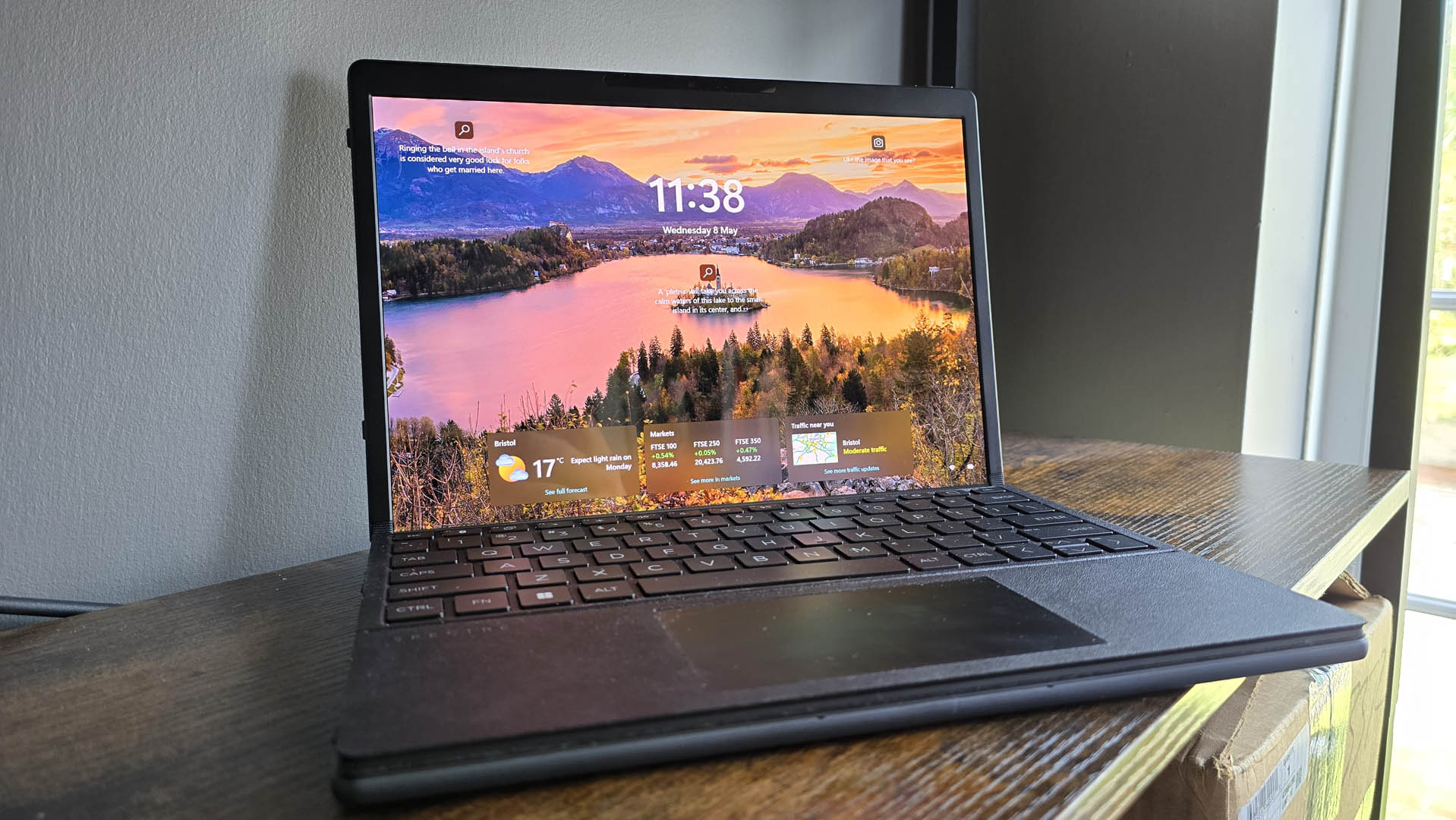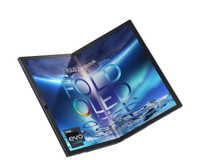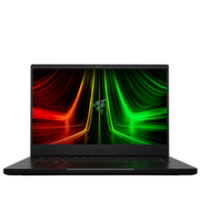TechRadar Verdict
With a foldable OLED panel, and a huge amount of flexibility, at first glance HP’s Spectre Foldable 17 looks to be a brilliant advancement in the world of somewhat stagnant laptops, seemingly blurring the lines between notebook, tablet, and all-in-one PC. However, its beauty is only surface deep. This device has too many flaws and foibles to make it worth investing in for the long-term. Simply put, the eye-watering price tag is ridiculous and absolutely doesn’t match up with the hardware inside. As a result, the Spectre Foldable feels more like a gimmicky tech demo, rather than a fully-fledged product.
Pros
- +
Stunning overall design
- +
Crisp and incredible OLED panel
- +
Works as a tablet, laptop and all-in-one PC
Cons
- -
Ridiculous pricing
- -
Performance is poor
- -
Added extras are underwhelming
Why you can trust TechRadar
HP Spectre Foldable 17: Two-minute review
HP’s Spectre Foldable 17 is, on the surface, an interesting device. If you were to look at the product page or any of the marketing material for the Foldable 17, no doubt you’d be impressed with the folding OLED panel, its crisp resolution, and the insane versatility that comes with it.
That magnetic keyboard, shifting the display up and altering the resolution automatically, and the fact you can use it as a fully-fledged all-in-one PC, or a 17-inch tablet at the drop of a hat, is no word of a lie – and incredibly enticing. But really, that’s all a mirage, a ghostly silhouette of what – at its core – is a significantly flawed product.
Right now, there’s one spec available for the HP Spectre Foldable. It’s priced at $5,000 retail in the US (£4,850 in the UK, or AU$8,499 in Australia), and features an Intel Core i7-1250U processor, 16GB of LPDDR5 RAM (running at 5200MHz), a 1TB M.2 PCIe 4.0 SSD, and a 94.3Wh battery.
That’s honestly all there really is to say about it. You get a pen, a USB dock, along with a (fairly average) detachable Bluetooth laptop substitute keyboard-and-mouse-combo-thing, and that’s it. And it’s the hardware that really drives the nail into the coffin.
Yes, the screen is good – it’s a beautifully crisp OLED panel that recreates colors to an exceptional degree. It’s stunning to look at, bright at 500 nits, and can even shift its resolution from 1,920 x 2,560 to 1,920 x 1,820 depending on how you position that keyboard. But, here’s the thing: you’re paying effectively $5,000 for a screen with a bit of hardware attached. And that hardware doesn’t perform as well as laptops that are a fifth the cost of this HP offering. Huawei’s MateBook D 16 for example, or Dell’s XPS 13 Plus, or literally any other laptop really, will outperform this device. And that’s a problem.
If all you need is a laptop to edit documents on (and I’ll caveat that with “not large spreadsheets”), watch a bit of Netflix, and stream a touch of YouTube, then yes the HP Spectre Foldable will fit the bill. Yes, you can technically use it as an all-in-one or a tablet to do that as well, but then you’re paying $5,000 for that privilege when, to be frank, you could probably get as much, if not better, performance out of an OLED TV for half the cost.
HP Spectre Foldable 17: Price and availability
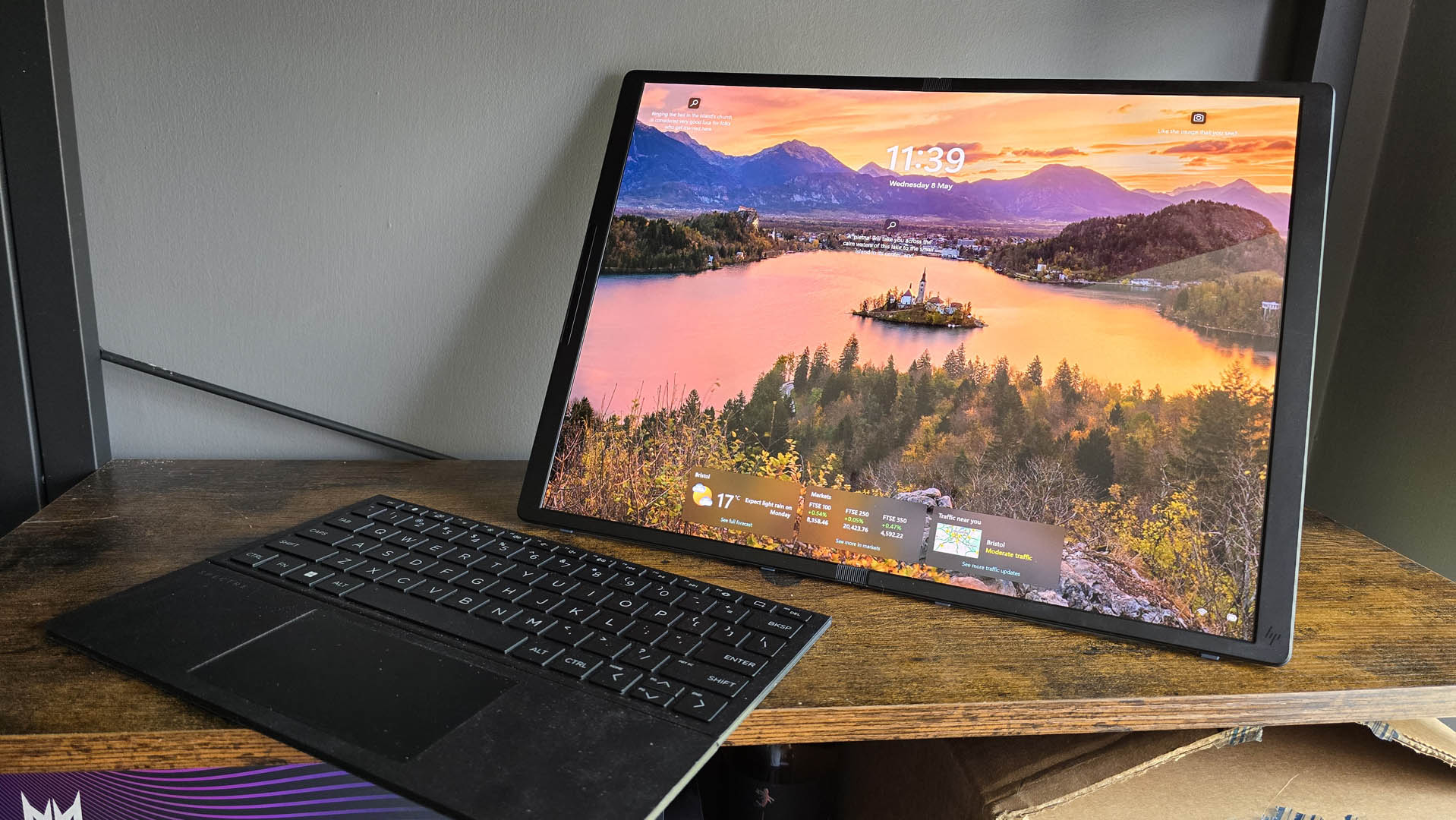
- How much does it cost? $5,000 / £4,850 / AU$8,499
- When is it out? It’s available right now
- Where can you get it? In the US, UK, and Australia
The price for the HP Spectre Foldable 17 is eye-watering. There is only one model available, priced at $5,000, or £4,850 in the UK, or if you live in Australia, AU$8,499.
This device goes by different names dependent on the region (Foldable in the US and Australia, or just Fold in the UK), but they are effectively the same model. All of them feature that 17-inch OLED panel, 16GB of soldered LPDDR5 RAM, and an Intel Core i7-1250U at their heart.
As to where you can buy the Spectre, the places to go are Amazon and Best Buy in the US, Amazon in the UK, and the HP store directly in Australia. There’s another big problem with the price, though, and that’s the fact that the Asus Zenbook 17 Fold OLED exists, certainly in the UK anyway.
On paper, and to be honest, even at a quick glance, these two products are pretty much identical. The one difference being the Zenbook 17 Fold comes in (for the exact same spec) at a much lower £3,299 as standard (although we’ve seen it as low as £2,299). You can buy the Asus Fold in the US, but only from eBay sellers at this point, for similarly low prices.
- Value: 1.5 / 5
HP Spectre Foldable 17: Design and Features
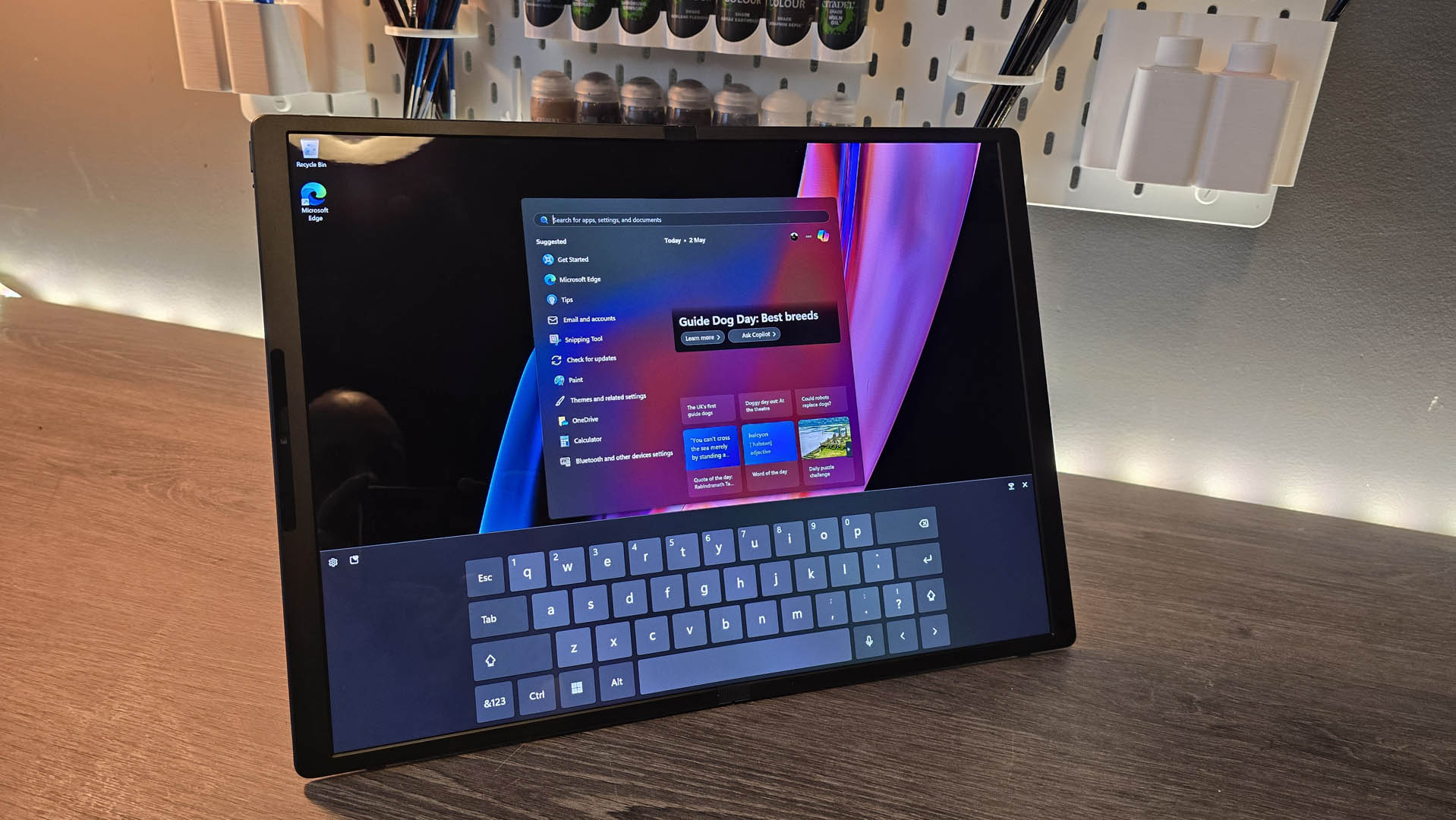
- Beautiful display
- Materials are solid
- Port selection is disappointing
So we’ve established that this is a premium product. The Foldable certainly doesn’t pull any punches when it comes to that price tag, but the same can’t quite be said for the overall design, however.
Let’s start by addressing the good points. That OLED display is incredible. As standard it’s a 17-inch foldable screen that comes with a 2.5K resolution, 500 nits of brightness in HDR mode, and a ton of the usual features (including low blue light and brightview modes). It packs 1.07 billion colors into that array and produces a phenomenal 1,000,000:1 contrast ratio to back it up.
CPU: Intel Core i7-1250U
GPU: Intel Iris Xe Graphics
RAM: 16GB LPDDR5-5200
Storage: 1TB PCIe 4.0 SSD
Display: 17-inch 1920 x 2560, OLED, 500 nits
It is only a 60Hz panel, however, unlike some of the OLED screens now available, so it’s not quite as buttery smooth as some of the competition with fixed-screen displays. However, we have seen bendable OLED panels go well beyond 60Hz, with Corsair’s Xeneon Flex being perhaps one of the better examples of what’s possible with the tech in terms of refresh rate at least.
The real party trick, however, is that fold, and how it incorporates into the design of the device. Namely, this isn’t technically one product. It’s a laptop, an all-in-one PC, and a tablet, depending on how you configure it. In the rear of the unit, there’s a kickstand that you can fold out to turn the Foldable into a pure 17-inch screen. You can then use the keyboard-trackpad combo to operate it like a standard desktop PC. Or alternatively, drop that kickstand, and convert it into a 17-inch tablet instead.
Create a slight bend in the screen and place it on your desk, then attach the keyboard to it (via the power of magnetism), and you’ve turned it into a laptop. Interestingly, with laptop mode HP has some nifty software installed that detects the keyboard’s position, and adjusts the screen size and resolution accordingly, depending on where you place the keyboard, which is pretty neat.
Rotation is supported as well: you can rotate the entire unit horizontally, one way or the other, and the display will twist to the correct orientation accordingly (although bear in mind that kickstand only works one way). In portrait mode, however, you are limited to one orientation.
That is mildly awkward, as this does place one of the only two USB-C ports on the top-left of the display. If you plug in the included USB dock on the bottom-right side of the screen, then your only option, if you want power in as well, is to have the cable trailing out of the top-left of the display, which looks pretty ghastly.
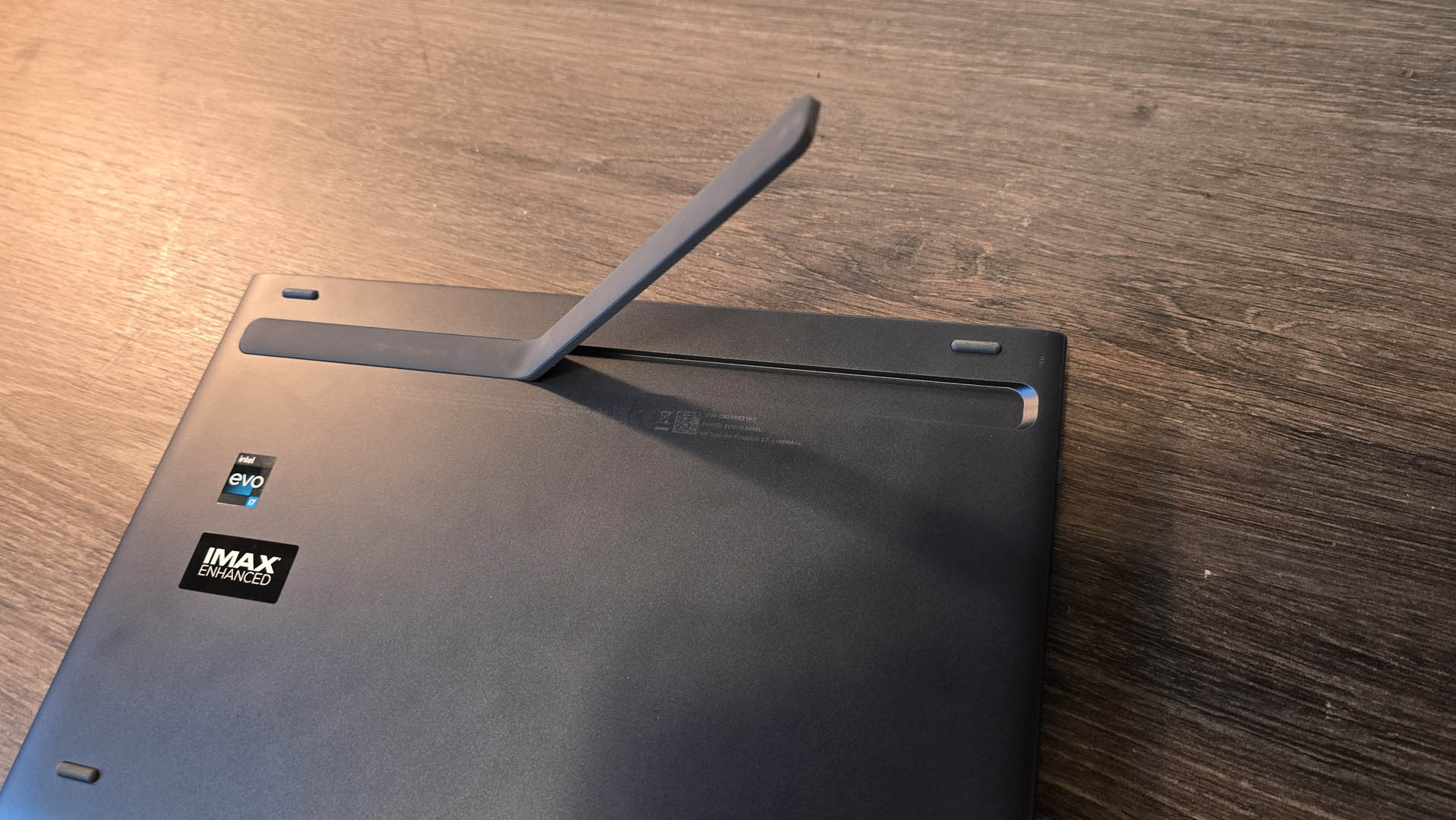
And it’s the ports that are the most frustrating to deal with. As standard, HP does include a USB hub with the foldable, but otherwise, you only get two USB-C Thunderbolt ports on here and nothing else. That’d be fine on a super-thin, small form factor device, but the Foldable is quite thick at 0.85cm, as that’s necessary to house all of that internal hardware.
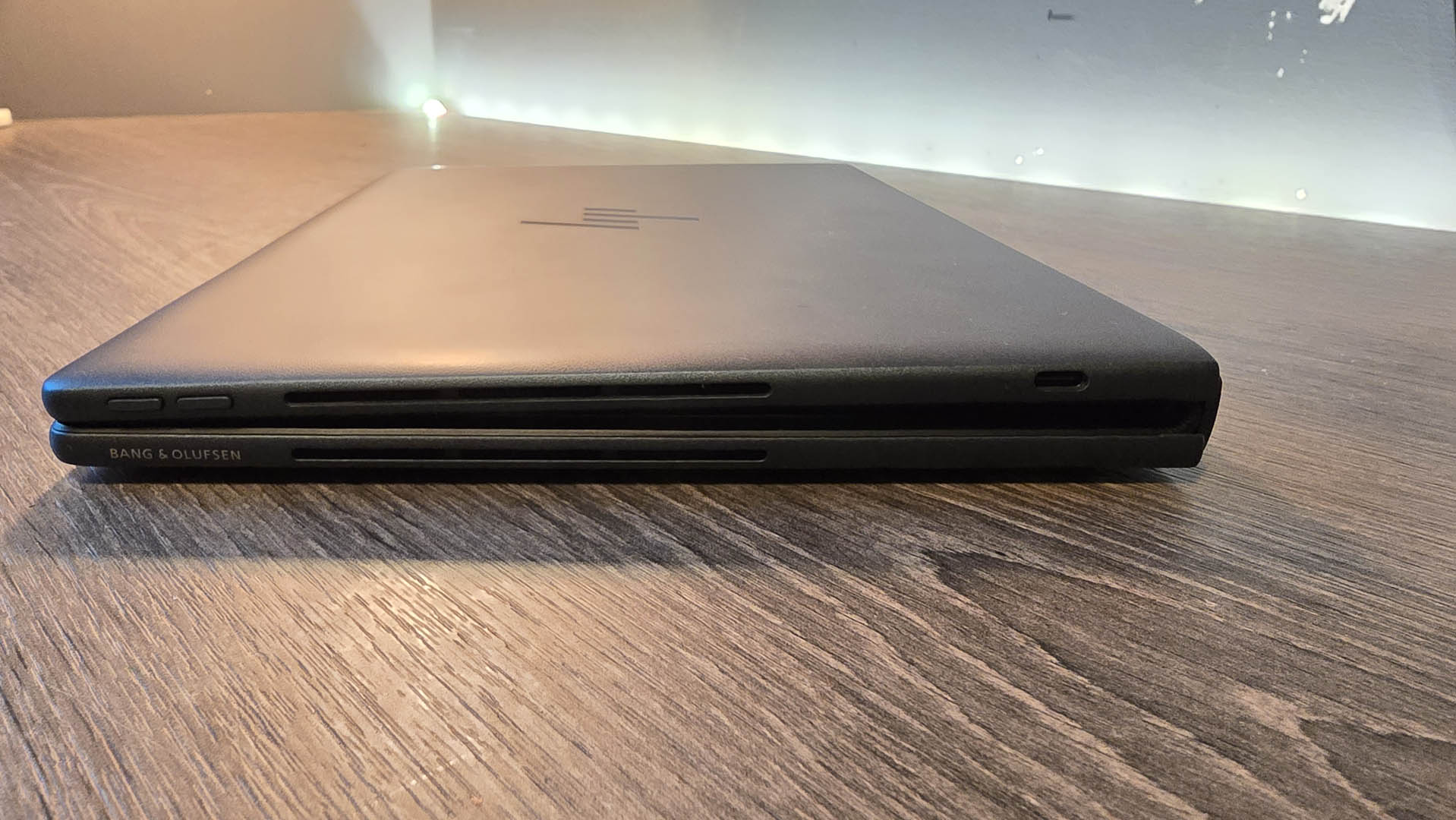
Then we get to the keyboard. It’s small, foldable, with fairly standard keys that feel okay touch-wise. It has a trackpad, a small amount of Spectre branding on there, and a soft-touch leather cover. It connects only via Bluetooth and has a 330-hour battery life. You can charge it wirelessly off the display (when it’s fully on the device), but otherwise you’re stuck with a proprietary charging cable instead.
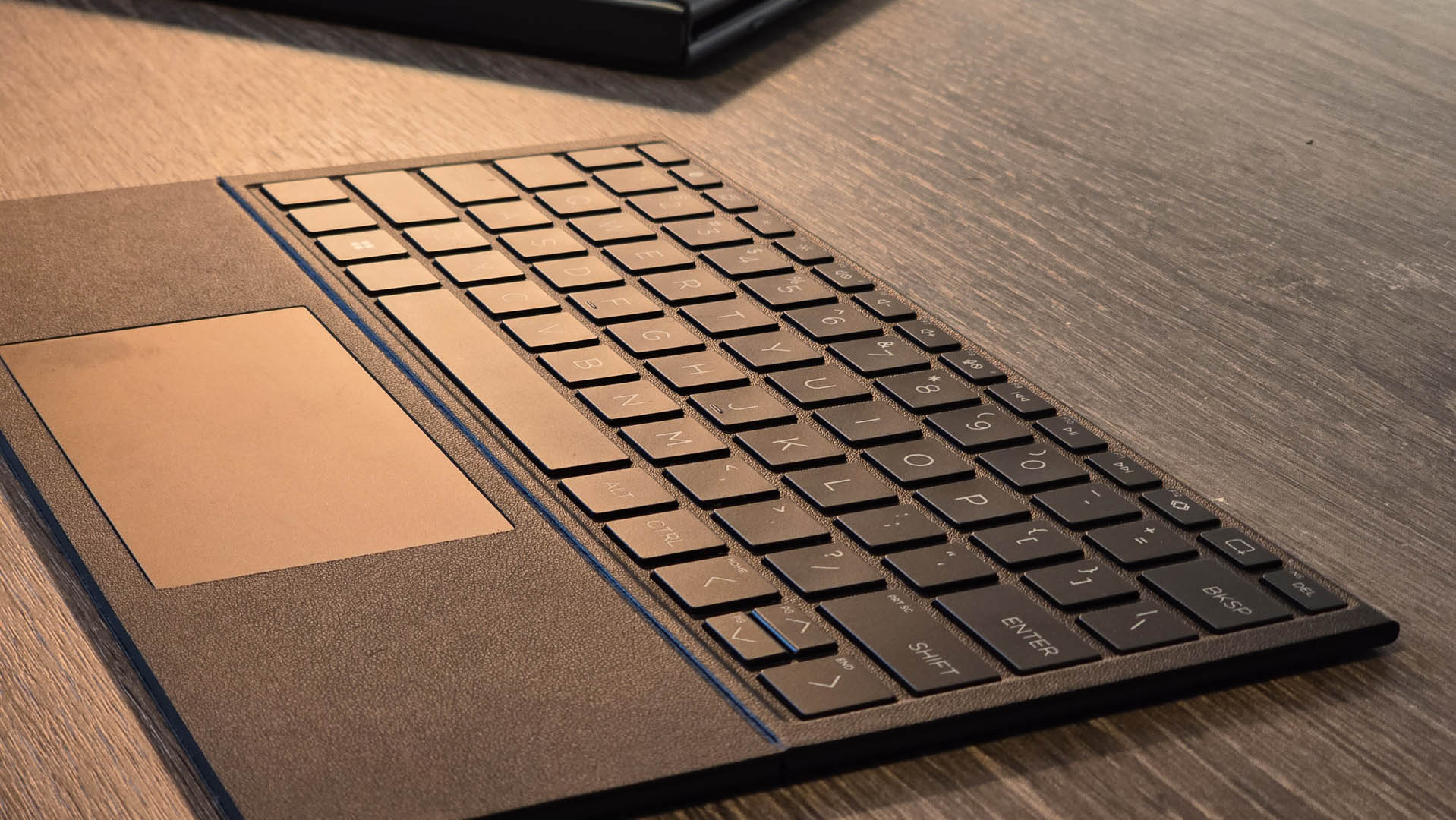
HP also reckons it should automatically pair with the Foldable 17 as well, but we consistently found that to be a weak point of the unit, particularly after restarting Windows, or letting the keyboard battery go flat. The one saving grace is you can magnetically stick the keyboard on the display, leave it there, and close the device without worry.
- Design: 3.5 / 5
HP Spectre Foldable 17: Performance
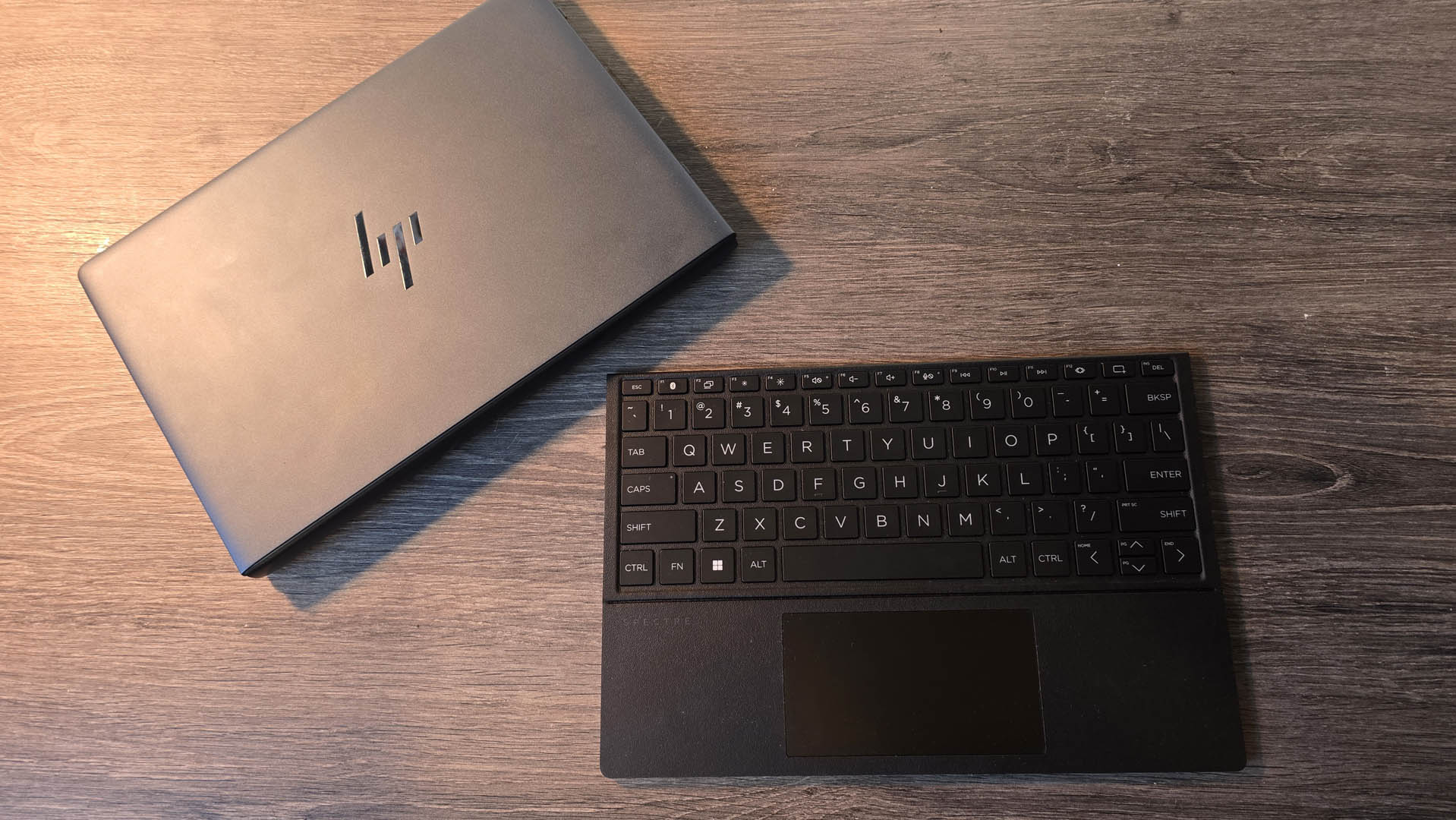
- Fine for light usage
- Gaming and heavy productivity isn't possible
So, the design side of the equation, except for a few minor or indeed more major pitfalls depending on your perspective, is pretty okay to be fair. There are a few foibles, particularly with the keyboard and placement of ports, but generally speaking, disregarding the price, the HP Foldable is an awesome product.
However, coming to its performance, this is where things take a turn for the worse. Now let’s be clear, you have to look at this with that price in mind: $5,000 is no small sum, particularly for a laptop like this.
I took it for a spin, benchmarking it across all manner of tests, just to see how the Foldable would perform. My test conditions were strict, and it was plugged in, and on the high-performance power plan in Windows, with all of the latest updates applied, and chipset/drivers installed. I ran a number of tests, including Crossmark, Geekbench 6.2.1, Blender, and some limited gaming benchmarks as well.
Now, Intel’s integrated Iris graphics has come a long way, but it’s still nowhere near the calibre of the Alchemist architecture found in the Arc graphics cards. It’s just not going to be one of the best gaming laptops, and that’s fine, it’s not meant to be. However, when you’re spending $5,000 you do expect a modicum of performance.
In Geekbench 6.2.1 the Foldable scored 2,210 in single-core and 6,635 in multi-core. By comparison, the Huawei Matebook D 16 scored 2,605 in single-core and 12,568 in multi-core. That’s double the multi-threaded performance in comparison, from a laptop that clocks in at 25% of the price. The Foldable did have a slight edge when it came to CrystalDiskMark clocking in at 6,739MB/s for reads and 4,524MB/s for writes (sequential), but then we came to the gaming, or lack thereof.
No matter what I tried, not one single benchmark would complete. In 3DMark Wildlife Extreme and Extreme Unlimited (tests designed for mobile gaming), the Foldable didn’t meet the minimum requirements, and Solar Bay (mobile ray tracing) was the same. I also tried Borderlands 3 and Total War: Warhammer III, on their lowest settings, and despite making it to the main menu, neither game would load the benchmark without crashing.
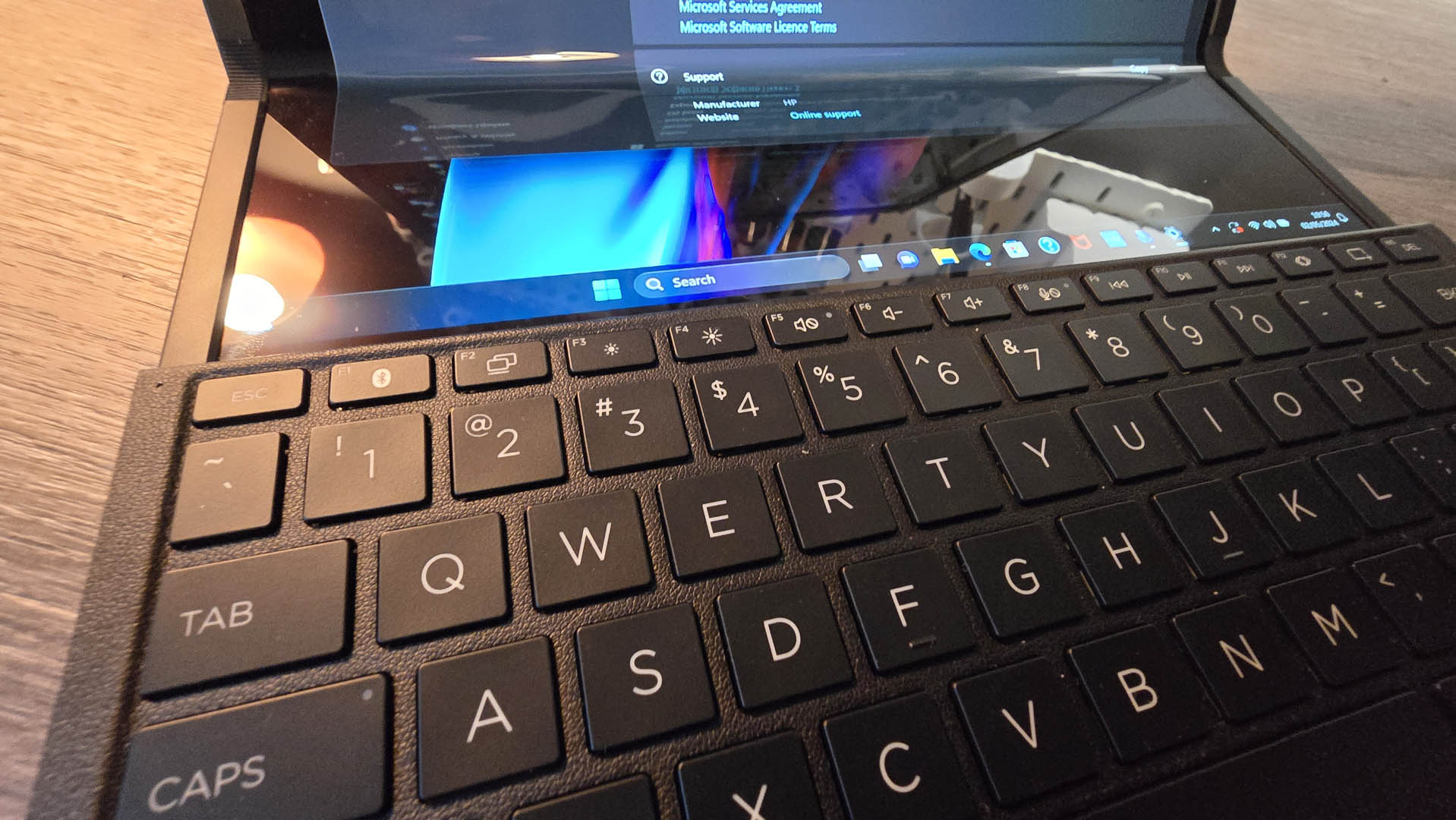
Blender performance was pretty dire too, at 26.81 for scene one, 17.14 for scene two, and 11.69 for scene three – less than half the performance of our comparative Huawei Matebook D 16. Likewise, Crossmark also got a pummelling across all four results, with scores ranging anywhere between 30-40% worse than the £1,200 Huawei notebook.
Clearly, when it comes to PC games this HP device isn’t going to be as capable as any of the best gaming desktops out there right now. Something like a dedicated gaming PC packing an Nvidia RTX 4080 Super, and maybe Intel Core i9-14900K, is obviously going to run rings around the Foldable 17.
However, the problem goes beyond this, as you could literally go out right now, and spend $3,500 to pick up a PC with a Ryzen 9 7900X, RTX 4070 Super, 64GB of DDR5 RAM, a 2TB PCIe 4.0 SSD, and a 32-inch 4K OLED screen, and still have $1,500 left over to get a good laptop. Or alternatively, if all you want is a powerhouse laptop with a stunning screen, you could spend $2,500 on something like an Asus Zenbook Pro 16X OLED and save yourself a ton of cash while getting way, way better performance levels.
If all you care about is streaming content on Netflix, or doing some light document work, and browsing the web, the HP Spectre Foldable is more than capable of that. But then, so is practically every laptop at every price point, even the budget ones, and for that crazy four-figure investment, you should expect more.
- Performance: 1.5 / 5
HP Spectre Foldable 17: Battery life
- Solid 11-hour battery life
For battery life, the HP Spectre Foldable performed well enough and pretty much met our expectations across the board. It wasn’t phenomenal by any means, but lasted a full day of working remotely, with wireless and Bluetooth devices connected to it.
As standard, the Foldable comes with a 6-cell 94.3Wh Li-ion polymer battery and is rated in its folded mode, with keyboard attached, at around 12.5 hours, which is roughly what I saw during my time testing.
If you detach the keyboard entirely and run the Foldable as a display, that time does drop, as you’re effectively enabling more pixels to be active as you are running a higher resolution – but otherwise, it’s still fairly consistent in that regard.
HP also has fast charging support on the Foldable as well, and with any 100W USB-C charger, you’ll get around 50% charge in 40 to 45 minutes, with a full charge taking a little over two hours in my testing.
- Battery life: 4 / 5
Should you buy the HP Spectre Foldable 17?
Buy it if...
You’re looking for a beautiful and unique screen
The HP Spectre Foldable has a stunning OLED panel. The screen offers a crisp resolution and high pixel density, and awesome color accuracy to boot.
You want a highly versatile device
If you’re after a tablet, a laptop, and an all-in-one PC that’s capable of light productivity work, the Foldable is a solid pick.
Don't buy it if...
You want a good value device
Performance is incredibly poor, and the Foldable is not without faults. Compounding that, the almost identical Asus Zenbook Fold comes in at nearly half the price.
You’re looking to game on it
In our testing, we couldn’t get any games to run at the native resolution at all without locking up the entire device, even when powered.
HP Spectre Foldable: Also Consider
Asus Zenbook 17 Fold OLED
It’s cheaper, slightly older, but identical in pretty much every area, and it comes with a price tag that’s half that of the HP Spectre Foldable.
Read our full review: Asus Zenbook 17 Fold OLED
Razer Blade 14 (2024)
If gaming is your aim, Razer’s Blade 14 (2024 edition) has it all with a number of pricing options, a clean design, and phenomenal performance coupled with a beautiful display.
Read our full review: Razer Blade 14 (2024)
HP Spectre Foldable 17: Report card
| Attributes | Notes | Score |
|---|---|---|
| Value | The sad fact is the HP Spectre Foldable is just insanely overpriced for what it is. The performance you get is lackluster and you can pick up far better for almost 25% of the cost. | 1.5 / 5 |
| Design | Overall design is solid, the screen is beautiful, and that flexibility is a treat. It’s just let down by poor port placement, and an underwhelming keyboard. | 3.5 / 5 |
| Performance | Combined with the pricing, performance is sadly laughable. Gaming is a no-go and heavy productivity stutters. If light productivity, web browsing, and content streaming are your thing, then it’s okay at that, but so is everything else. | 1.5 / 5 |
| Battery Life | If you need to use this all day in an office or at your local coffee shop, it’s a treat and will hold up well. Fast charge taking 45 minutes to ramp up to 50% battery life is also solid. | 4 / 5 |
| Total | The HP Spectre Foldable is sadly just too pricey for what you get. The screen is great, but without decent performance behind it, this device feels more like a gimmicky tech demo, rather than a fully-fledged product. | 2.5 / 5 |
- First reviewed June 2024

Zak is one of TechRadar's multi-faceted freelance tech journalists. He's written for an absolute plethora of tech publications over the years and has worked for Techradar on and off since 2015. Most famously, Zak led Maximum PC as its Editor-in-Chief from 2020 through to the end of 2021, having worked his way up from Staff Writer. Zak currently writes for Maximum PC, TechRadar, PCGamesN, and Trusted Reviews. He also had a stint working as Corsair's Public Relations Specialist in the UK, which has given him a particularly good insight into the inner workings of larger companies in the industry. He left in 2023, coming back to journalism once more. When he's not building PCs, reviewing hardware, or gaming, you can often find Zak working at his local coffee shop as First Barista, or out in the Wye Valley shooting American Flat Bows.
